2016 Hyundai Grand Santa Fe weight
[x] Cancel search: weightPage 10 of 717
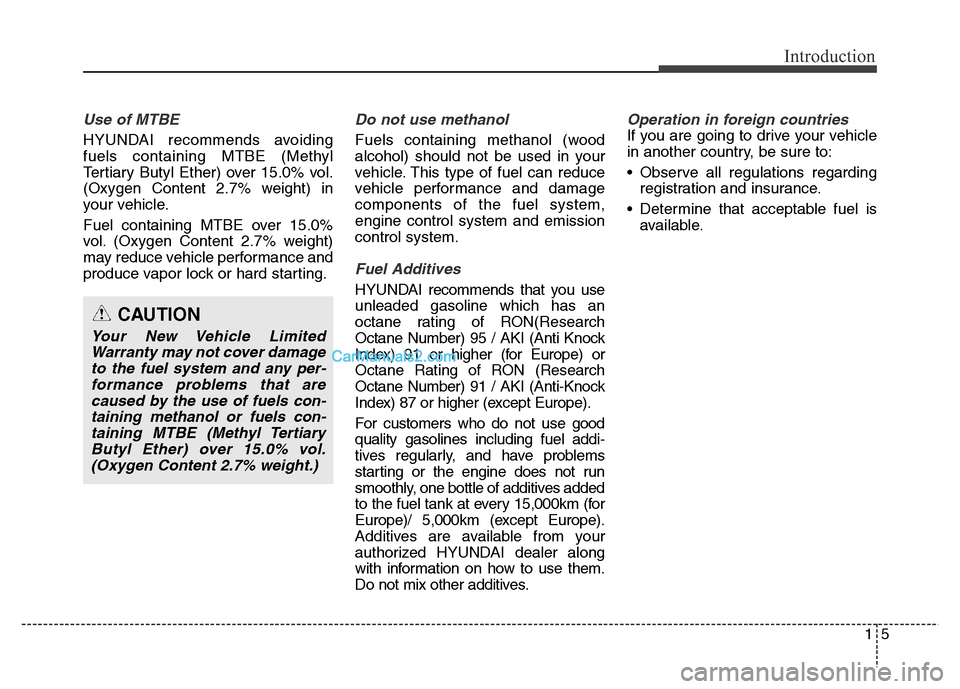
15
Introduction
Use of MTBE
HYUNDAI recommends avoiding
fuels containing MTBE (Methyl
Tertiary Butyl Ether) over 15.0% vol.
(Oxygen Content 2.7% weight) in
your vehicle.
Fuel containing MTBE over 15.0%
vol. (Oxygen Content 2.7% weight)
may reduce vehicle performance and
produce vapor lock or hard starting.
Do not use methanol
Fuels containing methanol (wood
alcohol) should not be used in your
vehicle. This type of fuel can reduce
vehicle performance and damage
components of the fuel system,
engine control system and emission
control system.
Fuel Additives
HYUNDAI recommends that you use
unleaded gasoline which has an
octane rating of RON(Research
Octane Number) 95 / AKI (Anti Knock
Index) 91 or higher (for Europe) or
Octane Rating of RON (Research
Octane Number) 91 / AKI (Anti-Knock
Index) 87 or higher (except Europe).
For customers who do not use good
quality gasolines including fuel addi-
tives regularly, and have problems
starting or the engine does not run
smoothly, one bottle of additives added
to the fuel tank at every 15,000km (for
Europe)/ 5,000km (except Europe).
Additives are available from your
authorized HYUNDAI dealer along
with information on how to use them.
Do not mix other additives.
Operation in foreign countries
If you are going to drive your vehicle
in another country, be sure to:
• Observe all regulations regarding
registration and insurance.
• Determine that acceptable fuel is
available.
CAUTION
Your New Vehicle Limited
Warranty may not cover damage
to the fuel system and any per-
formance problems that are
caused by the use of fuels con-
taining methanol or fuels con-
taining MTBE (Methyl Tertiary
Butyl Ether) over 15.0% vol.
(Oxygen Content 2.7% weight.)
Page 56 of 717
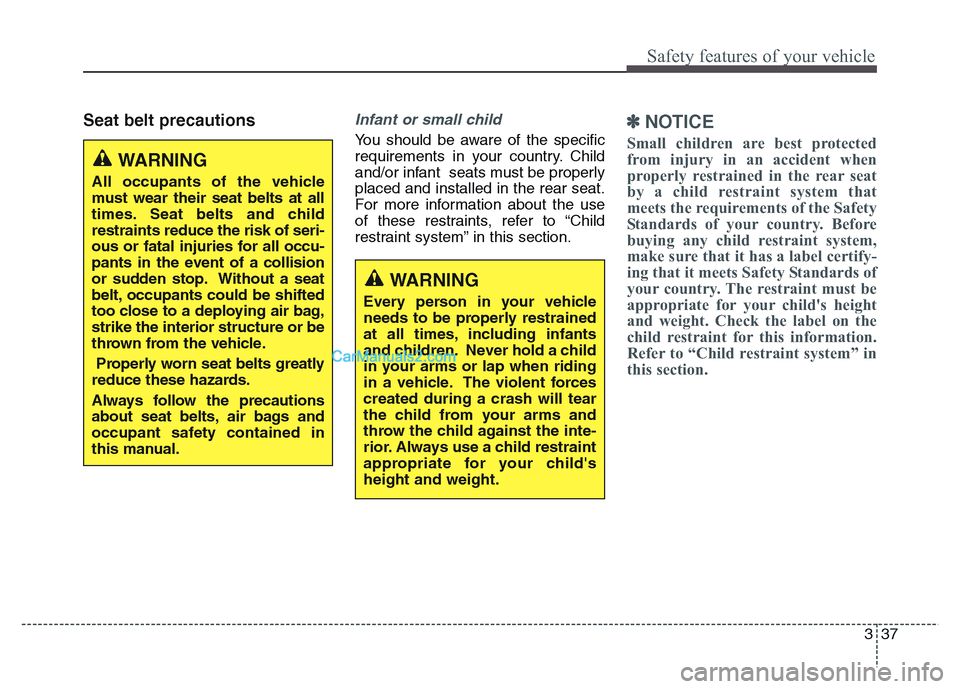
337
Safety features of your vehicle
Seat belt precautionsInfant or small child
You should be aware of the specific
requirements in your country. Child
and/or infant seats must be properly
placed and installed in the rear seat.
For more information about the use
of these restraints, refer to “Child
restraint system” in this section.
✽NOTICE
Small children are best protected
from injury in an accident when
properly restrained in the rear seat
by a child restraint system that
meets the requirements of the Safety
Standards of your country. Before
buying any child restraint system,
make sure that it has a label certify-
ing that it meets Safety Standards of
your country. The restraint must be
appropriate for your child's height
and weight. Check the label on the
child restraint for this information.
Refer to “Child restraint system” in
this section.
WARNING
All occupants of the vehicle
must wear their seat belts at all
times. Seat belts and child
restraints reduce the risk of seri-
ous or fatal injuries for all occu-
pants in the event of a collision
or sudden stop. Without a seat
belt, occupants could be shifted
too close to a deploying air bag,
strike the interior structure or be
thrown from the vehicle.
Properly worn seat belts greatly
reduce these hazards.
Always follow the precautions
about seat belts, air bags and
occupant safety contained in
this manual.
WARNING
Every person in your vehicle
needs to be properly restrained
at all times, including infants
and children. Never hold a child
in your arms or lap when riding
in a vehicle. The violent forces
created during a crash will tear
the child from your arms and
throw the child against the inte-
rior. Always use a child restraint
appropriate for your child's
height and weight.
Page 125 of 717
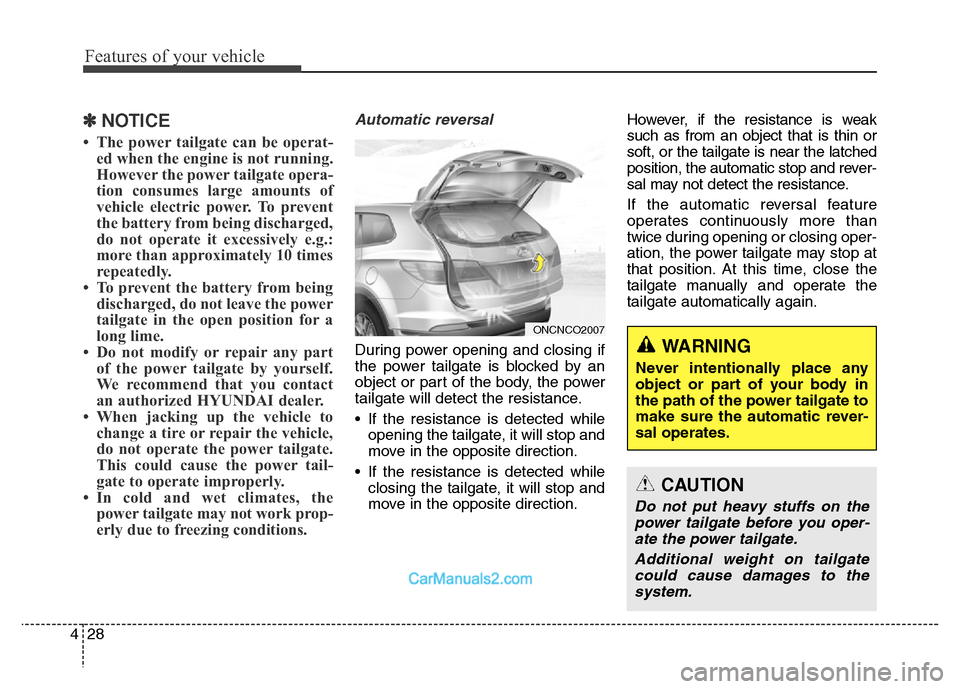
Features of your vehicle
28 4
✽NOTICE
• The power tailgate can be operat-
ed when the engine is not running.
However the power tailgate opera-
tion consumes large amounts of
vehicle electric power. To prevent
the battery from being discharged,
do not operate it excessively e.g.:
more than approximately 10 times
repeatedly.
• To prevent the battery from being
discharged, do not leave the power
tailgate in the open position for a
long lime.
• Do not modify or repair any part
of the power tailgate by yourself.
We recommend that you contact
an authorized HYUNDAI dealer.
• When jacking up the vehicle to
change a tire or repair the vehicle,
do not operate the power tailgate.
This could cause the power tail-
gate to operate improperly.
• In cold and wet climates, the
power tailgate may not work prop-
erly due to freezing conditions.
Automatic reversal
During power opening and closing if
the power tailgate is blocked by an
object or part of the body, the power
tailgate will detect the resistance.
• If the resistance is detected while
opening the tailgate, it will stop and
move in the opposite direction.
• If the resistance is detected while
closing the tailgate, it will stop and
move in the opposite direction.However, if the resistance is weak
such as from an object that is thin or
soft, or the tailgate is near the latched
position, the automatic stop and rever-
sal may not detect the resistance.
If the automatic reversal feature
operates continuously more than
twice during opening or closing oper-
ation, the power tailgate may stop at
that position. At this time, close the
tailgate manually and operate the
tailgate automatically again.
ONCNCO2007
WARNING
Never intentionally place any
object or part of your body in
the path of the power tailgate to
make sure the automatic rever-
sal operates.
CAUTION
Do not put heavy stuffs on the
power tailgate before you oper-
ate the power tailgate.
Additional weight on tailgate
could cause damages to the
system.
Page 231 of 717
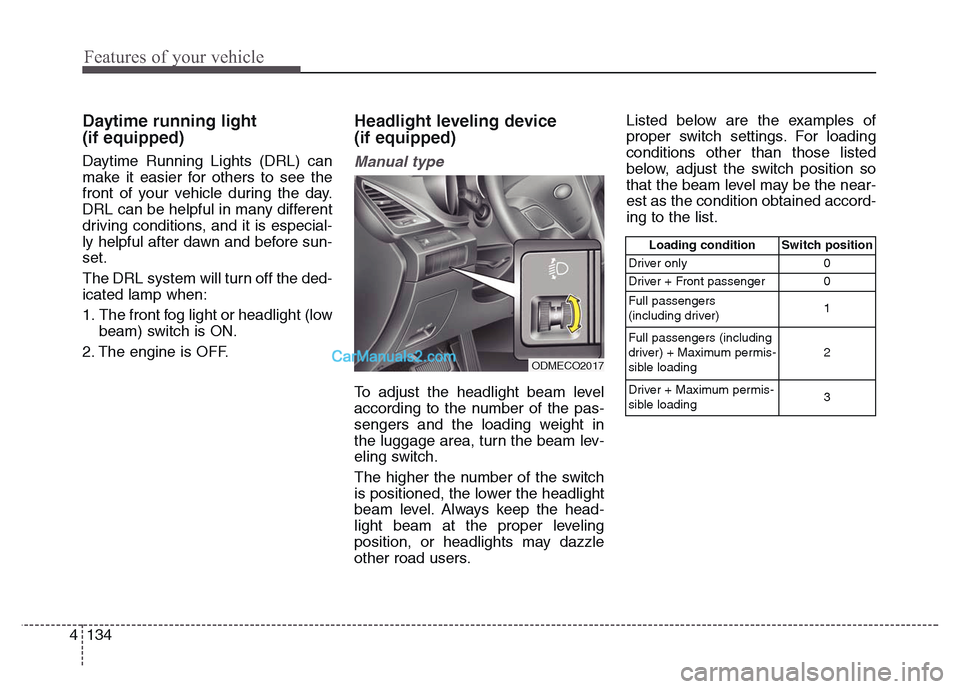
Features of your vehicle
134 4
Daytime running light
(if equipped)
Daytime Running Lights (DRL) can
make it easier for others to see the
front of your vehicle during the day.
DRL can be helpful in many different
driving conditions, and it is especial-
ly helpful after dawn and before sun-
set.
The DRL system will turn off the ded-
icated lamp when:
1. The front fog light or headlight (low
beam) switch is ON.
2. The engine is OFF.
Headlight leveling device
(if equipped)
Manual type
To adjust the headlight beam level
according to the number of the pas-
sengers and the loading weight in
the luggage area, turn the beam lev-
eling switch.
The higher the number of the switch
is positioned, the lower the headlight
beam level. Always keep the head-
light beam at the proper leveling
position, or headlights may dazzle
other road users.Listed below are the examples of
proper switch settings. For loading
conditions other than those listed
below, adjust the switch position so
that the beam level may be the near-
est as the condition obtained accord-
ing to the list.
Loading condition Switch position
Driver only 0
Driver + Front passenger 0
Full passengers
(including driver)1
Full passengers (including
driver) + Maximum permis-
sible loading2
Driver + Maximum permis-
sible loading 3
ODMECO2017
Page 232 of 717

4 135
Features of your vehicle
Automatic type
It automatically adjusts the headlight
beam level according to the number
of passengers and loading weight in
the luggage area.
And it offers proper headlight beam
under various conditions.
Adaptive front lighting system
(AFLS) (if equipped)
Adaptive front lighting system uses
the steering angle and vehicle
speed, to keep your field of vision
wide by swiveling and leveling the
headlamp.
Change the switch to the AUTO posi-
tion when the engine is running. The
adaptive front lighting system will
operate when the headlamp is ON.
To turn off the AFLS, change the
switch to other positions. After turn-
ing the AFLS off, headlamp swiveling
no longer occurs, but leveling oper-
ates continuously.If the AFLS malfunction indicator
comes on, the AFLS is not working
properly. Drive to the nearest safe
location and restart the engine. If the
indicator continuously remains on,
we recommend that you take your
vehicle to an authorized HYUNDAI
dealer and have the system checked.
ODM042247
ODMECO2018
WARNING
If it does not work properly even
though your car is inclined
backward according to passen-
ger's posture, or the headlight
beam is irradiated to the high or
low position, we recommend
that you have your vehicle
inspected by an authorized
HYUNDAI dealer.
Do not attempt to inspect or
replace the wiring yourself.
Page 288 of 717
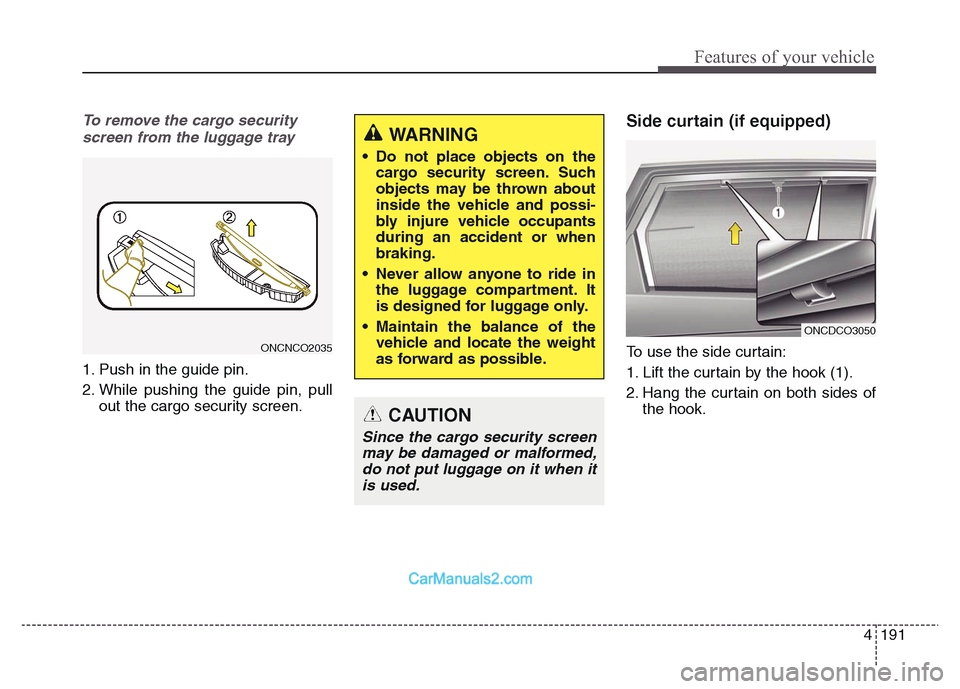
4 191
Features of your vehicle
To remove the cargo security
screen from the luggage tray
1. Push in the guide pin.
2. While pushing the guide pin, pull
out the cargo security screen.
Side curtain (if equipped)
To use the side curtain:
1. Lift the curtain by the hook (1).
2. Hang the curtain on both sides of
the hook.
ONCDCO3050
WARNING
• Do not place objects on the
cargo security screen. Such
objects may be thrown about
inside the vehicle and possi-
bly injure vehicle occupants
during an accident or when
braking.
• Never allow anyone to ride in
the luggage compartment. It
is designed for luggage only.
• Maintain the balance of the
vehicle and locate the weight
as forward as possible.
CAUTION
Since the cargo security screen
may be damaged or malformed,
do not put luggage on it when it
is used.
ONCNCO2035
Page 289 of 717

Features of your vehicle
192 4
EXTERIOR FEATURES
Roof rack (if equipped)
If the vehicle has a roof rack, you can
load cargo on top of your vehicle.
✽NOTICE
If the vehicle is equipped with a sun-
roof, be sure not to position cargo
onto the roof rack in such a way that
it could interfere with sunroof oper-
ation.
ODM042345
CAUTION
• When carrying cargo on the
roof rack, take the necessary
precautions to make sure the
cargo does not damage the
roof of the vehicle.
• When carrying large objects
on the roof rack, make sure
they do not exceed the overall
roof length or width.
WARNING
• The following specification is
the maximum weight that can
be loaded onto the roof rack.
Distribute the load as evenly
as possible onto the roof rack
and secure the load firmly.
Loading cargo or luggage in
excess of the specified weight
limit on the roof rack may
damage your vehicle.
• The vehicle center of gravity
will be higher when items are
loaded onto the roof rack.
Avoid sudden starts, braking,
sharp turns, abrupt maneu-
vers or high speeds that may
result in loss of vehicle con-
trol or rollover resulting in an
accident.
(Continued)
ROOF 100 kg (220 lbs.)
RACK EVENLY DISTRIBUTED
Page 451 of 717
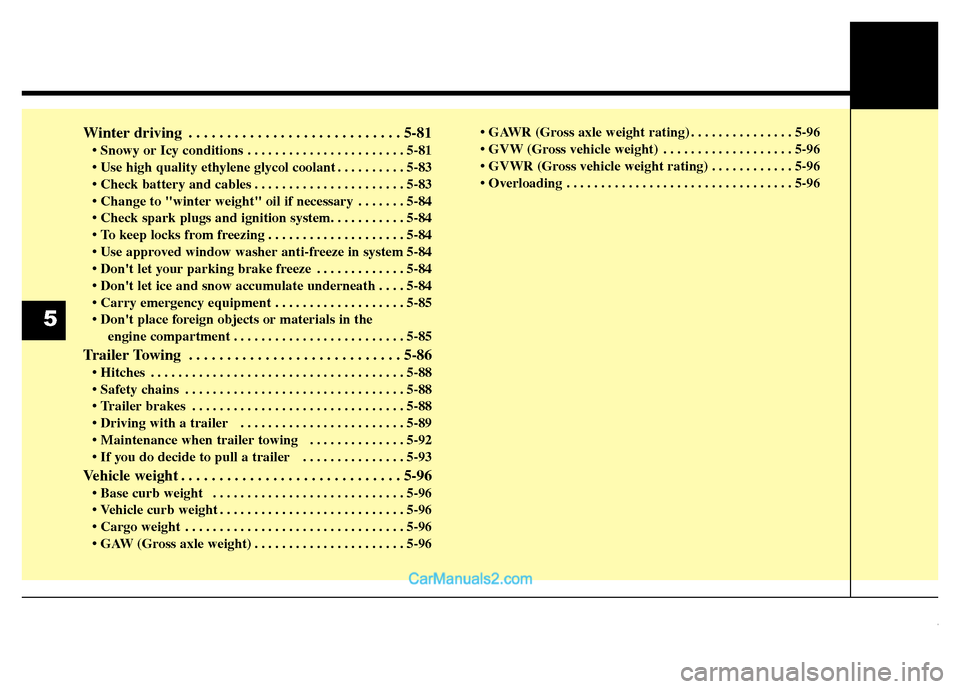
Winter driving . . . . . . . . . . . . . . . . . . . . . . . . . . . . 5-81
• Snowy or Icy conditions . . . . . . . . . . . . . . . . . . . . . . . 5-81
• Use high quality ethylene glycol coolant . . . . . . . . . . 5-83
• Check battery and cables . . . . . . . . . . . . . . . . . . . . . . 5-83
• Change to "winter weight" oil if necessary . . . . . . . 5-84
• Check spark plugs and ignition system. . . . . . . . . . . 5-84
• To keep locks from freezing . . . . . . . . . . . . . . . . . . . . 5-84
• Use approved window washer anti-freeze in system 5-84
• Don't let your parking brake freeze . . . . . . . . . . . . . 5-84
• Don't let ice and snow accumulate underneath . . . . 5-84
• Carry emergency equipment . . . . . . . . . . . . . . . . . . . 5-85
• Don't place foreign objects or materials in the
engine compartment . . . . . . . . . . . . . . . . . . . . . . . . . 5-85
Trailer Towing . . . . . . . . . . . . . . . . . . . . . . . . . . . . 5-86
• Hitches . . . . . . . . . . . . . . . . . . . . . . . . . . . . . . . . . . . . . 5-88
• Safety chains . . . . . . . . . . . . . . . . . . . . . . . . . . . . . . . . 5-88
• Trailer brakes . . . . . . . . . . . . . . . . . . . . . . . . . . . . . . . 5-88
• Driving with a trailer . . . . . . . . . . . . . . . . . . . . . . . . 5-89
• Maintenance when trailer towing . . . . . . . . . . . . . . 5-92
• If you do decide to pull a trailer . . . . . . . . . . . . . . . 5-93
Vehicle weight . . . . . . . . . . . . . . . . . . . . . . . . . . . . . 5-96
• Base curb weight . . . . . . . . . . . . . . . . . . . . . . . . . . . . 5-96
• Vehicle curb weight . . . . . . . . . . . . . . . . . . . . . . . . . . . 5-96
• Cargo weight . . . . . . . . . . . . . . . . . . . . . . . . . . . . . . . . 5-96
• GAW (Gross axle weight) . . . . . . . . . . . . . . . . . . . . . . 5-96• GAWR (Gross axle weight rating) . . . . . . . . . . . . . . . 5-96
• GVW (Gross vehicle weight) . . . . . . . . . . . . . . . . . . . 5-96
• GVWR (Gross vehicle weight rating) . . . . . . . . . . . . 5-96
• Overloading . . . . . . . . . . . . . . . . . . . . . . . . . . . . . . . . . 5-96
5